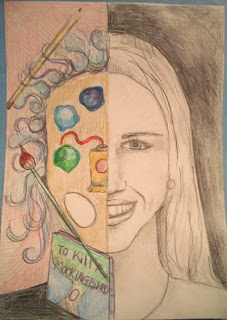
Objective: Students will draw half a realistic self-portrait by looking in a mirror and drawing what they see and from learning about how the human face proportions.
Students will draw the other side of their self-portrait abstractly by drawing who they think they are not what they look like, using symbols, shapes, and objects.
Students will make a portrait that shows technical skills using the pencils, color, shading, value and composition by learning about each term and how they look in a work of art.
Art History:
Students will have prior knowledge of historical self-portraits and why artists make them by doing a token response to some historical self-portraits.
Art Criticism:
Students will be able to name 3 strengths and 2 areas to work on of a classmate's work by participate in an art critique.
They will explain why they created their portrait as they did by writing an artist statement.
Aesthetics:
Students will formulate opinions about if art has to be made for others or can it be made for oneself and does that take away from its value or beauty by have a class discussion.
II. Overview of Lesson (Main message)
Self-portraits have been done by many artists. They are records of where the artist has come from and who they were at the time. They should age changing as well as artistic styles developing. They are useful tools to get to know the artist and trace their lives. The students will make a self-portrait that is split down the middle. One side is realistic and one side is abstract showing who they are inside. It is snap-shot in time that will show both what they look like at the time and who they are, their interests, and developmental abilities.
III. Art Concept(s)/Vocabulary:
Abstraction, symbolism, contour line, shading, cross-hatching, value, proportions, Contour, line, highlights, composition, realistic
Art making Processes and Techniques: Sketch, layout, measure
Art Elements/Principles of Design:
Value, shape, line, balance, proportion











